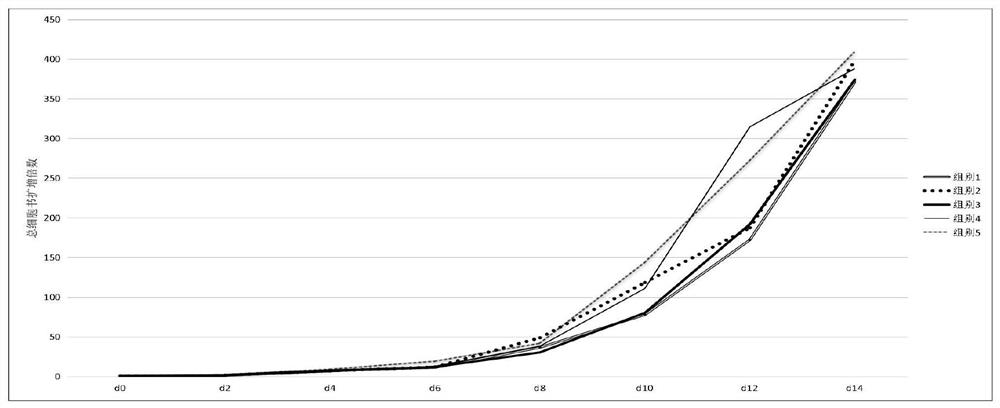Method for co-culturing natural killer cells by umbilical cord mesenchymal stem cells
A technology of natural killer cells and stem cells, applied in the field of umbilical cord mesenchymal stem cells co-cultivation of natural killer cells, can solve the problems of low cell biological activity, inconsistent cell sources, and high cost of quality control
- Summary
- Abstract
- Description
- Claims
- Application Information
AI Technical Summary
Problems solved by technology
Method used
Image
Examples
Embodiment 1
[0069] Example 1: The co-culture cell expansion curve of umbilical cord blood nucleated cells and umbilical cord mesenchymal stem cells. Stem cells to the P5 generation were temporarily frozen and stored in a liquid nitrogen tank after the cells were prepared. According to the technical scheme of the present invention, 1.2*10^7 cells of umbilical cord blood nucleated cells and 1.2*10^8 cells of P5 generation umbilical cord mesenchymal stem cells were resuscitated in a 37°C water bath for each batch. According to the cell counting results, inoculate in 100ml complete co-culture medium at a density of 1.0*10^6cells / ml for umbilical cord blood nucleated cells and 1.0*10^7cells / ml for P5 generation umbilical cord mesenchymal stem cells. Subsequent cultures were cultured in 2L cell culture bags under the conditions of 37°C, saturated humidity, and 5% CO2, and samples were taken and counted every 2 days during the culture process. After sampling and counting, add fresh co-culture c...
Embodiment 2
[0072] Example 2: Colony differentiation statistics after co-culture of umbilical cord blood nucleated cells and umbilical cord mesenchymal stem cells, recovery and washing of umbilical cord blood nucleated cells obtained from five groups of isolated nucleated cells and co-cultured and expanded nucleated cells in Example 1 After washing with DMEM to adjust the cell density to 1*10^6cells / ml, take 100ul and 900ul Stemcell MethoCult human hematopoietic stem cell methylcellulose medium and mix them evenly, and inoculate them in a 24-well plate, with 3 replicate wells for each group. The 24-well plates were cultured at 37°C, saturated humidity, and 5% CO2 for 14 to 16 days, and colonies were counted.
[0073] Results: After 16 days of culture, count the number of hematopoietic cell colonies in the 24-well plate under a microscope as follows:
[0074]
[0075]
[0076] Table 1 Colony differentiation statistics of umbilical cord blood nucleated cells and umbilical cord mesench...
Embodiment 3
[0078] Example 3: Flow cytometric phenotype statistics of umbilical cord blood nucleated cells CD3-CD56+ after sorting, the nucleated cells obtained according to Example 1 of the present invention were sorted by CD3-CD56+ MACS magnetic beads according to the technical scheme of the present invention, using After flow cytometry detection, the cell purity of the NK cell phenotype CD3-CD16+CD56+ before sorting and after sorting was counted respectively.
[0079] Before sorting After sorting Group 1 20.45% 98.77% Group 2 19.56% 97.53% Group 3 15.34% 94.35% Group 4 12.56% 97.12% Group 5 14.37% 96.51%
[0080] Table: 2 is the comparison of NK cell purity before and after MACS CD3-CD56+ sorting
[0081] Conclusion: MACS magnetic bead sorting can effectively purify NK cells and their precursor cells.
PUM
 Login to View More
Login to View More Abstract
Description
Claims
Application Information
 Login to View More
Login to View More - R&D
- Intellectual Property
- Life Sciences
- Materials
- Tech Scout
- Unparalleled Data Quality
- Higher Quality Content
- 60% Fewer Hallucinations
Browse by: Latest US Patents, China's latest patents, Technical Efficacy Thesaurus, Application Domain, Technology Topic, Popular Technical Reports.
© 2025 PatSnap. All rights reserved.Legal|Privacy policy|Modern Slavery Act Transparency Statement|Sitemap|About US| Contact US: help@patsnap.com



